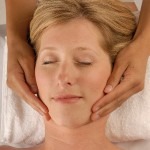Craniosacral Therapy
According to the Cleveland Clinic Craniosacral Therapy can bring some relief to cancer patients, simply by helping them relax. This could be considered very similar to the Autonomous Sensory Meridian Response we discussed in a prior post.
Massage is about improving blood flow which increases the speed of healing. So this is why our clients love Cranioscral Therapy–they feel better and think more effectively.
Whatever you call it, massaging the head feels fabulous! Read on to learn more about what the Cleveland Clinic says about this important therapy.
Other common name(s): cranial balancing, cranial osteopathy, cranial sacral manipulation, craniopathy

Scientific/medical name(s): none
Description
Craniosacral therapy involves light touches on the bones of the skull (including the face and mouth), spine, and pelvis to release tension and improve body movement.
Overview
Available scientific evidence does not support claims that craniosacral therapy helps in treating cancer or any other disease. But it may help some people with cancer feel more relaxed. The gentle, hands-on method may offer some relief for symptoms of stress and tension.
How is it promoted for use?
Craniosacral therapy is a variation of chiropractic and osteopathic medicine (see our documents, Chiropractic and Osteopathic Medicine). Supporters claim that gentle pressure on the bones of the head, spine, and pelvis increases the flow of cerebrospinal fluid and can cure or help a number of ailments.
Craniosacral therapists say that there is a link between the fluid in the head and the sacrum (the base of the lower back) and that the rhythm of the fluid that flows between these areas can be detected like a pulse. They claim that their treatment normalizes, balances, and gets rid of blockages (obstructions) in various systems throughout the body. They say that with blockages removed, the body can function in a healthy manner.
Promoters claim this therapy can be used to help relieve headaches; neck and back pain; problems with the temporomandibular joint (the hinge of the jaw, often called the TMJ); chronic fatigue; poor coordination; eye problems; depression; hyperactivity; attention deficit disorder; problems with the central nervous system, the immune system, and the endocrine system; and many other conditions.
Practitioners also claim that the birth process can cause problems with growth of the cartilage and membranes surrounding an infant’s skull. They offer craniosacral therapy to fix this problem.
What does it involve?
Craniosacral therapy is usually performed by osteopaths, chiropractors, and massage therapists. The treatment involves pressure or manipulation of the bones of the skull. Sessions last from 30 minutes to an hour.
What is the history behind it?
Dr. William G. Sutherland developed cranial osteopathy in the early 1930s. John E. Upledger, DO, derived craniosacral therapy from Sutherland’s work and developed it in the 1970s. Upledger opened the Upledger Institute of Florida in the 1980s, where thousands of people attend his program every year to learn about releasing stresses in the skull and the membranes around the brain.
What is the evidence?
The theory on which craniosacral therapy is based is not consistent with the scientific understanding of anatomy and physiology of the skull, brain, and spinal fluid circulation. The bones of the adult human skull are effectively fused except after severe head trauma.
There are mostly individual (anecdotal) reports of treatment success with craniosacral therapy. Some patients report that it helps to reduce stress, tension, and headaches. But there have been very few well-controlled clinical studies of this method.
Researchers have since tested the ability of craniosacral therapists to detect and count the rhythmic cranial impulse, an important part of the therapy. A number of therapists looked at the same patients at the same time, without comparing notes. The therapists’ counts did not match, which suggests that these counts were not reliable. The British Columbia Office of Health Technology Assessment conducted a wide-ranging search for solid information on craniosacral therapy and found no evidence to support the claims made about it.
Recent studies that have been designed to look at craniosacral therapy often still have problems with control groups and other aspects of the studies. One well-designed study from 2011 looked at quality of life in children with cerebral palsy and found no improvement in those who got cranial osteopathy over those who didn’t.
A review published in 2012 evaluated the published evidence from randomized controlled clinical trials (RCTs), considered the “gold standard” for comparing a treatment to a placebo or to another treatment. The researcher concluded that “very few RCTs of CST [craniosacral therapy] exist. Most of these trials are seriously flawed [and consequently, not useful in evaluating this treatment]. Therefore, there is insufficient evidence to suggest that CST has therapeutic effects beyond placebo.”
Are there any possible problems or complications?
Craniosacral therapy should not be used in children under age two because the bones of the skull are not fully developed. In one small study, several adults with head injuries had worse symptoms after starting craniosacral therapy. People who have cancer and chronic conditions such as arthritis and heart disease should talk to their doctor before starting any type of therapy that involves moving joints and muscles.
Relying on this treatment alone and delaying or avoiding conventional medical care for cancer may have serious health consequences.
Cace Holmseth, BFA, LMT, CMT is a licensed Medical Massage therapist who works with physicians to help patients reach optimal health. Call him at 612-269-2207 to make your appointment.